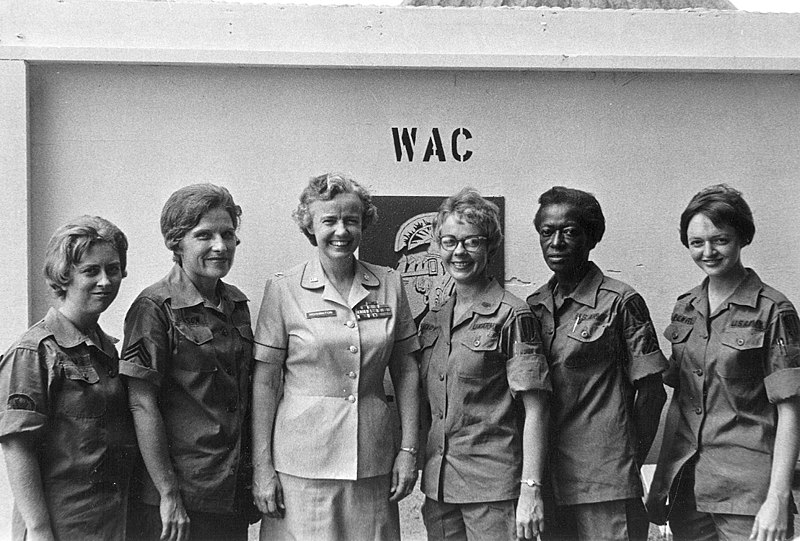While women made strides during World War II and Korea to be integrated into the military, Vietnam felt like a step backward as the military initially resisted sending women into any career field to Vietnam.
Then, when the military realized they needed to rely on women from the medical career field, it was still a slow process to add more women to the fight. But as the years passed more women were sent overseas. Many women chose not to serve in the military but were civilians supporting various humanitarian agencies and covering news. While the primary field of the women who served overseas was nursing, there were a number of women outside the medical career field who made an impact on the war and helped lead changes for women in the military.
US Army Women
The first Army nurses arrived in Vietnam in 1956. Their primary job was to train the South Vietnamese nursing skills. The nurses would remain and grow in strength with approximately 5,000 women serving from March 1962 to March 1973. Five Army nurses died during the conflict, including Lieutenant Colonel Annie Ruth Graham and First Lieutenant Sharon Ann Lane.
In 1964, Gen William Westmoreland asked the Pentagon to provide Women’s Army Corps (WAC) members to help the South Vietnamese train their own women’s Army corps. In 1970, when WAC was at its peak, there were 20 officers and 130 enlisted women serving in Vietnam.
US Air Force Women
The Air Force leadership resisted sending women overseas. When the first Air Force Nurses arrived in Vietnam in 1966, it was out of demand and lack of men in the nursing career field. Once the door opened for women to be overseas as nurses, the door for other career fields opened up as well. Women quickly began to take over the duties that their male counterparts had been assigned. In 1967, the first Women in the Air Force (WAF) members served at the headquarters in Saigon. One of the first women in the Air Force to reach the rank of General, Brig Gen Wilma Vaught, ret, was deployed for Vietnam and served in Saigon for a year.
One Air Force nurse died. Captain Mary Therese Klinger died in a C-5 crash that was supporting Operation Babylift which worked to transport babies from orphanages to America for asylum and adoption. She was the last nurse and the only U.S. Air Force Nurse to die in Vietnam.

US Navy Women
The U.S. Navy Nurse Corps began to play an important role during the Vietnam War in 1963. And then in 1964 five Navy Nurses were awarded Purple Hearts after being injured during a bombing on Christmas Eve. They were the first women to receive Purple Hearts during Vietnam.
Only nine women outside the Nurse career field served overseas during Vietnam. The first, in 1967, was Lieutenant Elizabeth G. Wylie. She worked in the Command Information Center as part of the staff of the Commander of Naval Forces in Saigon. She would spend three to six days each month in the field taking pictures and gathering information. She was never under hostile fire and loved, “the opportunity to see the heart of the Navy at work.” In 1972, Commander Elizabeth Barrett became the first female Naval Line Officer to hold command in a combat zone.
Many women volunteered to go overseas but were not given a chance. Women were used within the Navy to backfill positions both at home and in Europe to allow more men to go overseas. Without them directly supporting the war effort, the Navy would have struggled to continue on.
US Marine Corps Women
Women Marines had a small presence in Vietnam. It wasn’t until March 1967 that the first woman Marine arrived in Vietnam. Master Sergeant Barbara Dulinsky was the first to arrive in-country and worked at Military Assistance Command, which was headquartered in Saigon. In total, women Marines in Vietnam normally numbered between eight to 10 enlisted members with one to two officers. There were a total of 28 enlisted women and eight officers between 1967 to 1973.
Civilian Women
Military women were not the only women who went overseas to support the war effort. Civilian women worked for a number of organizations to support the war. The Red Cross, USO, Army Special Service and Peace Corps all relied on women to meet their mission. Other women came to Vietnam as foreign correspondents for news organizations. Georgette “Dickey” Chappelle was a writer for the National Observer and was killed by a mine while on patrol with U.S. Marines outside of Chu Lai in November of 1965. In total, 59 civilian women died during the conflict.
One thing to note about the women who served in Vietnam was that all of the women who served overseas were volunteers. They ranged in age from freshly graduated college students in their 20s to seasoned career women in their 40s. Finding the service records and the history of military women and civilians in Vietnam is like trying to piece together a puzzle with lots of missing pieces. Women did not expect special recognition and were just looking for a way to be a part of the fight. They didn’t stand out or request to be excluded; instead they fought to be part of the effort and we can’t forget their contribution and the lives lost.


